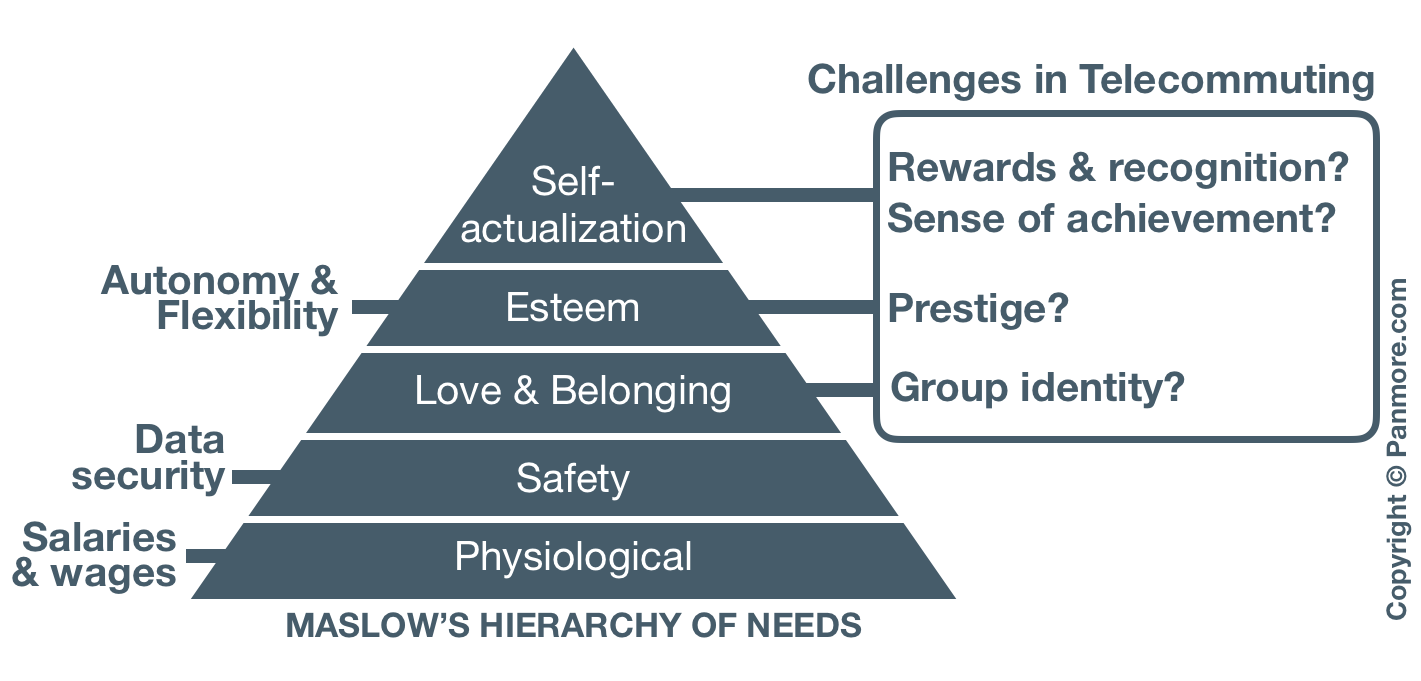
Telecommuting or “work from home” is a practical approach to human resource management to accomplish business objectives. Virtual or hybrid work trends relate to strategic management goals specific to human resource development, as well as the satisfaction of employees’ needs based on Abraham Maslow’s Hierarchy of Needs. As more companies adopt telecommuting or teleworking, managers face an increasing need for solutions to maximize online technologies to support employee satisfaction, which relates to Maslow’s Hierarchy of Needs. This theoretical framework explains some of the factors that influence employees’ motivation to telework, as well as their satisfaction in such work. Multinational business organizations can use Maslow’s Hierarchy of Needs as part of optimizing their staffing policies and strategic management for human resources in telecommuting operations. Managers can use this theory to design approaches to optimize teleworkers’ job satisfaction and performance, despite the strategic issues and human resource management challenges that come with telecommuting.
In examining the significance of Maslow’s theory in developing human resources, particularly in telecommuting companies, managers need to consider the benefits of telework to employees in terms of the satisfaction of various needs, such as physiological, safety, belonging, esteem, and self-actualization. Telecommuting addresses these needs differently compared to non-telework. Business strategic planning for telecommuting must involve utilizing technologies and virtual processes to support employee development and the satisfaction of workers’ needs according to Maslow’s Hierarchy of Needs.
Characteristics of Telecommuting
Telecommuting is a work system and business strategy where workers fulfill their job requirements in locations outside the organization’s premises. Usually, these locations are the employees’ homes, referred to as “work from home.” However, telework is not limited to homes. For example, employees and teams have the option to work in co-working spaces. In essence, telecommuting allows business organizations to operate even when their employees are absent from the organization’s physical workspaces. The following are the characteristics of telecommuting that are relevant to applying Maslow’s Hierarchy of Needs theory.
Information and communication technologies (ICT) are integrated into business processes and internal communications. Companies use information and communication technologies to support telework or telecommuting, and to facilitate their organizational culture despite virtual operations. For example, in support of their respective work cultures, Intel, IBM, Google, Apple, Microsoft, Amazon, and Facebook have telecommuting and hybrid work policies for various business divisions and processes, and for various occasions or situations, such as pandemics. Even government agencies have mobile workers. In these organizations, ICTs are a foundation that makes telecommuting possible. Various companies can implement and benefit from telecommuting in similar ways.
In virtual organizations, individual employees and groups work remotely from each other. As the term suggests, telecommuting is all about doing one’s job at a distance from the traditional physical workplace. For example, in companies with telework arrangements, employees work from their homes or any other place where they can effectively complete their job tasks. This ability to complete work processes and maintain productive workflows is based on information and communication technologies integrated into organizational resources and processes. Thus, the effectiveness of telecommuting depends on the availability of the ICT used in the business organization.
Work flexibility and autonomy characterize human resources in remote work settings. When employees work remotely, they experience flexibility in how they do their work in the context of being in a virtual organization. Telecommuting frequently comes with flexible work schedules. For example, a work-from-home employee can alternate between doing her job and childcare each workday. Companies can also implement results-based approaches that require employees to achieve specific output, regardless of the amount of time that they spend working. In these examples, telecommuting enables workers to flexibly perform their jobs, while doing other activities that are not readily doable in traditional workplaces in companies’ premises. This flexible condition empowers remote workers to achieve autonomy during their workdays. For instance, a teleworker has the autonomy to decide on the current workday’s activities, as long as he satisfies the company’s job output requirements.
Maslow’s Hierarchy of Needs
Abraham Maslow’s theory on the hierarchy of needs describes different types of needs that start from the most basic (lowest level of the hierarchy) to the ultimate need (highest level of the hierarchy): physiological, safety, love and belonging, esteem, and self-actualization. This theory encompasses various aspects of life. A person’s activities can be viewed from Maslow’s theoretical lens. For example, an employee properly performs his job to have money to spend for his physiological needs, such as food. Also, it is possible that a person works for the purpose of satisfying not just his physiological needs, but also his need to belong, which is in the middle of Maslow’s Hierarchy of Needs. Moreover, in some cases, a person works because it leads to self-fulfillment and self-actualization, such as when the person aims to benefit society through his work. There are various ways of satisfying these needs, depending on the individual’s nature, goals, and preferences, among other factors.
Telecommuting to Satisfy Employees’ Needs Based on Maslow’s Hierarchy
Telework enables employees to earn a living. In Maslow’s Hierarchy of Needs, the telecommuter’s earnings contribute to the satisfaction of physiological needs and safety needs, which typically require financial resources. It is worth noting that this financial aspect is also true for non-telecommuting employment. Thus, regarding Maslow’s Hierarchy of Needs, income does not set telework apart from non-telework. Nonetheless, this financial factor contributes to the desirability of telecommuting. In human resource development and strategy, this financial factor of telecommuting contributes to employees’ satisfaction of needs toward self-actualization.

Data security is another factor that influences telecommuters’ satisfaction in their remote job situations. Companies’ information and communications technologies typically involve data security measures, such as encryption, anti-malware, and firewall implementations, usually following guidelines based on the CIA triad model for information security. Given adequate data protection, remote employees feel safe in performing their jobs over the Internet. This factor contributes to the satisfaction of safety needs in the context of Maslow’s Hierarchy of Needs. Safety needs pertain to security and personal well-being. Other factors that satisfy teleworkers’ safety needs are the reduced need to physically commute, which corresponds to lower exposure to air pollutants and lower risks of vehicular accidents.
Flexibility and autonomy are telecommuting characteristics that help satisfy employees’ esteem needs, which is a level lower than self-actualization needs, the highest needs in Maslow’s Hierarchy of Needs. Flexibility is based on the teleworker’s ability to engage in activities that are typically not doable in traditional or non-remote workplaces. For example, an employee working from home can attend to her children’s needs between job tasks throughout the workday. Also, remote employees experience autonomy when they have results-oriented jobs, which allow different approaches, as long as the desired results are achieved. In these contexts, flexibility and autonomy recognize teleworkers’ abilities. Such recognition contributes to the satisfaction of esteem needs in Maslow’s Hierarchy of Needs.
Telecommuting may be disadvantageous when it comes to teleworkers’ belonging needs, which are the third level in Maslow’s Hierarchy of Needs. The disadvantage is based on the physical distance between workers and the virtual nature of telework. For example, such distance makes it challenging for remote employees to feel that they belong to a team or organization. In the traditional way, workers experience belongingness face-to-face with coworkers. In contrast, in the telecommuting context, workers need to recognize such belongingness in the virtual sense.
In addition, self-esteem and self-actualization in Maslow’s Hierarchy of Needs may be difficult to address in telecommuting situations. This issue is due to the typical lack of a formal workplace among teleworkers. It may be difficult for remote workers to experience formal manifestations and recognition of their accomplishments. In addition, the virtual nature of their jobs reduces sensory input that signifies goal achievement and personal development, which affect employees’ esteem and self-actualization. This condition is especially notable among remote workers with menial jobs that have insignificant or absent recognition for achievements.
Addressing disadvantages requires business organizations to design telecommuting arrangements that optimize benefits while also supporting the satisfaction of teleworkers’ needs based on Maslow’s Hierarchy of Needs. Specific approaches depend on the company’s organizational culture, nature of jobs and business processes, and the remote work conditions of employees. Also, the technologies used for telecommuting influence how Maslow’s Hierarchy of Needs relates to employees’ job satisfaction. For example, among telecommuting workers, the availability of appropriate online tools influences their ability to complete tasks and their sense of accomplishment, which relates to esteem and self-actualization. Based on this significance of technology, sociotechnical systems theory relates to the application of Maslow’s Hierarchy of Needs in remote or hybrid work environments.
A strategy in designing telecommuting systems to address Maslow’s Hierarchy of Needs is to use the functional, security, and hedonic aspects. In this three-pronged approach, companies focus on satisfying the functional (physiological), security (safety; love and belonging), and hedonic (love and belonging, esteem, and self-actualization) needs of remote workers. This approach provides a simplified way of designing and evaluating telecommuting systems with specific consideration for Maslow’s Hierarchy of Needs. There are many other models, strategies, and tactics for applying this theory to the situation of remote employees. For example, managers can integrate group communication tools, such as real-time chat applications, into telecommuting systems to facilitate the sharing of ideas among teleworkers. Sharing addresses love and belonging needs in Maslow’s Hierarchy of Needs. Conducting monthly or weekly in-person face-to-face meetings, as well as providing a formal venue for personal development, rewards, and recognition can also improve employees’ morale and establish a sense of belonging. In the context of Maslow’s Hierarchy of Needs, regular meetings address love and belonging needs, esteem needs, and self-actualization needs.
References
- Bahar, B., & Özen, Ü. (2024). Research on the motivational factors of information technologies department employees in the context of Abraham Harold Maslow’s Hierarchy of Needs. Trends in Business and Economics, 38(4), 245-253.
- Compton, W. C. (2024). Self-actualization myths: What did Maslow really say? Journal of Humanistic Psychology, 64(5), 743-760.
- Ficapal-Cusí, P., Torrent-Sellens, J., Palos-Sanchez, P., & González-González, I. (2024). The telework performance dilemma: Exploring the role of trust, social isolation and fatigue. International Journal of Manpower, 45(1), 155-168.
- Lynden, K. D. (2024). A meta-review of global virtual team research: Thematic insights and future directions. Cross Cultural & Strategic Management, 31(2), 205-242.
- Mahadevan, J. (2024). Building Collaborative Cultures in Cross-Functional and Interdisciplinary Virtual Teams: Relationship Management, Project Time Planning and Workspace Organization. In Virtual Team Collaboration: A Guide for Individual Team Members (pp. 99-131). Wiesbaden: Springer Fachmedien Wiesbaden.
- Mahadevan, J. (2024). Digital Leadership and Virtual Team Collaboration: Options and Success Factors for Industry 4.0. In Virtual Team Collaboration: A Guide for Individual Team Members (pp. 165-195). Wiesbaden: Springer Fachmedien Wiesbaden.
- Ravhudzulo, H., & Eresia-Eke, C. (2024). Employee engagement, telecommuting propensity, and employee performance in the virtual workplace. Cogent Business & Management, 11(1), 2422559.